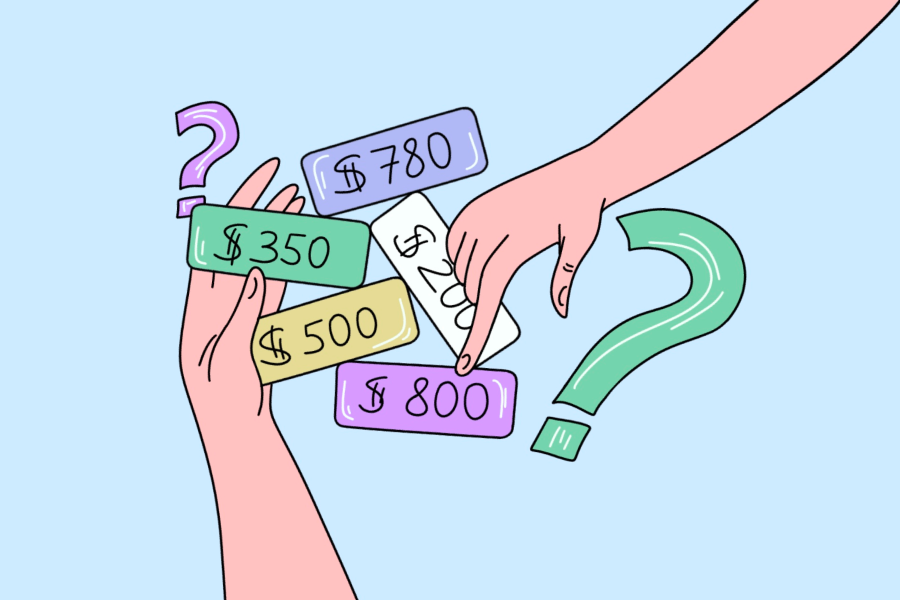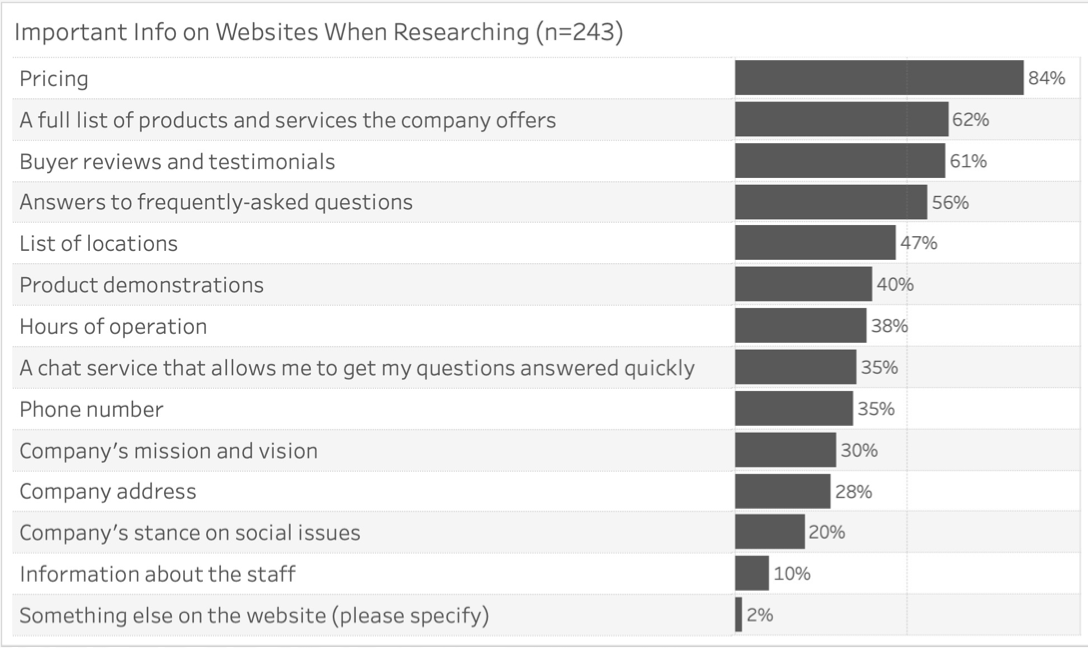Should I List Prices on My Website?
Explore the debated topic of whether or not to publish prices on your website. Learn about the pros and cons, alternative strategies, and questions to ask yourself before making a final decision.
July 31, 2025
July 31, 2025

Key points
- To 84% of potential clients, pricing is the most important piece of information to look for on a website;
- If customers don’t see your prices, they might think you are more expensive than you actually are;
- If you don't want to lose a potential client, but you also don't want to publicly display your rates, you have two alternative options: you can either include a "starting at" price on your website, or you can ask the client directly for their budget.
To list or not to list, that is the question. The one that is actively debated by many business owners and freelance professionals. This decision is a strategic one and can have a significant impact on your business. There are both pros and cons of listing your prices publicly. Let's take a closer look at these and see which would be the most suitable option for your business' needs!
Pros of listing prices on my website
Trust and transparency
Studies show that potential customers simply want to see the price on a website – 84% of people say that price is the most important piece of information they look for.

Listed prices demonstrate your transparency and build trust with your customers. According to Harvard Business Review, it is a significant source of competitive advantage that ultimately leads to revenue growth. It shows that you base your prices on the value of the service rather than on how much you think someone can afford to pay. In addition, it greatly enhances the customer experience — when prices are clearly displayed, there is no need for additional steps such as messaging or calling. It feels as if you are already caring about your customers' time and are focused on their needs.
Budgeting & information gathering
According to statistics, 96% of people do research on companies and products before contacting them. Showing your prices can be especially useful for people who are at the beginning of their search for the right professional to help them with their task and are simply gathering information about the price range in the market.
Let's imagine a scenario where someone is doing research and goes through 30 different websites to create a budget and find a pool of potential experts. If only 10 of them list prices on their website, there is a high chance that a customer will choose one of these 10 and not bother contacting the other 20 directly to check their prices.
Qualified leads
Listing prices on your website helps to filter out customers who may not be able to afford your services, thus saving you time and effort. Imagine spending time preparing for a sales meeting with a client who has a budget of $1,500, while your prices are starting at $3,000. A complete waste of time, unless you want to spend even more time trying to convince them of your worth. When prices are clearly displayed, you can be assured that people who sign up for a meeting or a call are comfortable with them and understand the value you are offering.
Unaffordability stigma
Some consumers perceive hidden prices as being unaffordably high. It's a strategy that is used by luxury brands and is aimed at people with so much money that they don't worry about the cost. Even in the Harry Potter series, when Harry saw the Firebolt broom for the first time, with a tag "price upon request," he immediately understood that the cost was too high and did not bother to check it. Whether this is the case for your business or not, it's an assumption that many people make: no visibles fees equals really expensive. Showing your rates will help you avoid losing potential customers due to assumptions that may not be true.
SEO improvement
Search Engine Optimization helps your website rank higher in search engines like Google by using specific keywords that users search for. Although product pricing isn’t a direct ranking factor, it can affect CTRs (click-through rates) and lift conversions. One study found that displaying price ranges resulted in 3.6% more product clicks. However, the results may vary depending on the category or industry. It’s quite understandable: statistics show that around 14% of searches are in the form of a question. And users often search for information with price in mind – for example, "how much does logo design cost?" or "what is the range of website designer prices in the US?". If your website provides answers to these questions and displays rates, it's more likely that it will be found by users searching for this information and visited by potential clients.
Cons of listing prices on my website
Customized services
Depending on the specific nature of your business, it may be difficult to simply set a price for your services and call it done. The cost of many services, especially in the creative field, can vary from client to client. You can see how logo design rates are calculated in our guide, for example.
Publicly posting what you charge can put you in a tight corner. Imagine having a conversation with a client and discovering that their specific project is more complex than average and will take longer to complete. On the one hand, it would not be fair to charge less than what you deserve, but on the other, it could be damaging to your reputation to post one cost online and then charge significantly more. The best approach would be to have a starting price to give the general idea of your range and still leave room for negotiation and customization.
When I can tell the story of my work first, pricing becomes a natural next step rather than a barrier. People invest in what they understand and believe in. Plus, every project is different. A startup founder's needs are different from an established business owner's needs. Having a conversation allows me to tailor both the solution and the investment to what makes sense for them.
{{Shambhavi Gupta}}
Value and context
Concealing prices redirects the focus from the cost of the product to its value. Listing a flat price without providing context can lead to confusion if a potential customer does not understand the scope of the work or the actual outcome they will receive. Let's face it, not every customer knows exactly what they want or need. Most only have a general idea, and without proper communication, you could lose potentially valuable customers. On the other hand, you could attract those who are only interested in the price and not other aspects of your product or service, which may be just as bad.

The goal isn't to hide pricing – it's to ensure people understand the value before they see the investment. Listing prices often attracts price-shoppers who focus on cost rather than value. When I don't list prices, the people who contact me are genuinely interested in solving their problem, not just comparing rates. The conversation itself qualifies them better than any price filter could.
{{Shambhavi Gupta}}
Competition
When your pricing is on full display, anyone can see them, including all of your competitors. They can lower their prices or match your offer, making it more attractive. This is a relevant concern, especially if your business operates in a local market or a highly competitive one with similar products or services that only differ in price.
However, it is more emotional than strategic. First of all, there are a number of tools that can help evaluate competitors' prices, like PriceShape or Prisync, so your competitors will get the general idea anyway. Or they can simply contact you, pretending to be a client, and get your pricing if they really want to. Second, ask yourself: does it really matter in your case? Don't get me wrong, it might be a factor in your pricing model. However, if you are placing a larger emphasis on the service itself and are unwilling to change your pricing under any circumstances, then it does not really matter what others do or offer.
My main reason for keeping prices private is that pricing needs context to make sense. However, yes – when competitors can see your pricing, they often try to undercut without understanding the value behind it. This actually works in my favor because clients who've spoken with me understand why my investment is justified.
{{Shambhavi Gupta}}
A strategy in the middle
Set a list of packages starting at a certain rate
This way, you can ensure that your price range is acceptable to potential clients, but the negotiation process will take place before the final price is determined.

Ask a client about their budget
When in doubt, just ask. Some may argue that this is not a good strategy, as Shambhavi believes it to be manipulative, but it still seems to work for some people. You can ask directly without offering a starting rate and see what you can offer for this budget, or provide a range to choose from.

How to decide?
The decision to show or hide prices depends on many factors: your audience, your approach, your services. This can be a tough one, so here’s a list of questions to ask yourself before you make a decision:
- Is your service customizable or well defined? If the price isn’t affected much by the client and their needs, you can show a fixed price. But if the project's requirements have a significant impact on the final cost, it's best to discuss this with the client beforehand.
- Do you have enough leads? If you already have a number of monthly projects that cover your needs, you can show your prices online so only 100% quality leads contact you. But if you don’t, show prices after discussing with the client. Yes, it may take more time to handle calls and emails, but you’ll get more leads that may become clients.
- Are you good at sales and enjoy them? You don’t need to show prices if you’re an expert at selling your value in a 1-to-1 conversation. If you hate sales conversations, you can show prices and establish your value through marketing and clear descriptions of what you offer. Add client testimonials and project details to demonstrate your professionalism and the value you provide.
- What’s your branding? Your prices show potential clients where you stand in the industry and the competition. Are you a low-cost professional or a premium one? There’s no right or wrong here: you can consider showing premium prices on your website or hiding them and selling directly and the same applies to when your prices are average. But if your prices are way below average, be cautious, prices that are much lower than expected may make clients assume your work is also lower quality which may not be the case.
Of course you’ll never know what works best for you until you try both. Run an A/B test – you can display pricing on your website for one month and then remove it for the next month to compare conversion rates.
Conclusion
Whether you show prices or not, it’s a personal business decision. Choose your pricing strategy wisely and base it on what’s best for your business and what feels right for you.
FAQ
We are here to ease your working routine
Whether you're freelancing or a full-time contractor, we simplify the working process, putting you in control.
Try it free


A practical guide to raising your rates and communicating the change clearly, professionally, and without unnecessary stress.

Check our guide about the best side hustles with a list of 15 second jobs at night from home for you to make more money every month.

Get tips and advice on how to build a strategy for your solopreneur social media.

.avif)